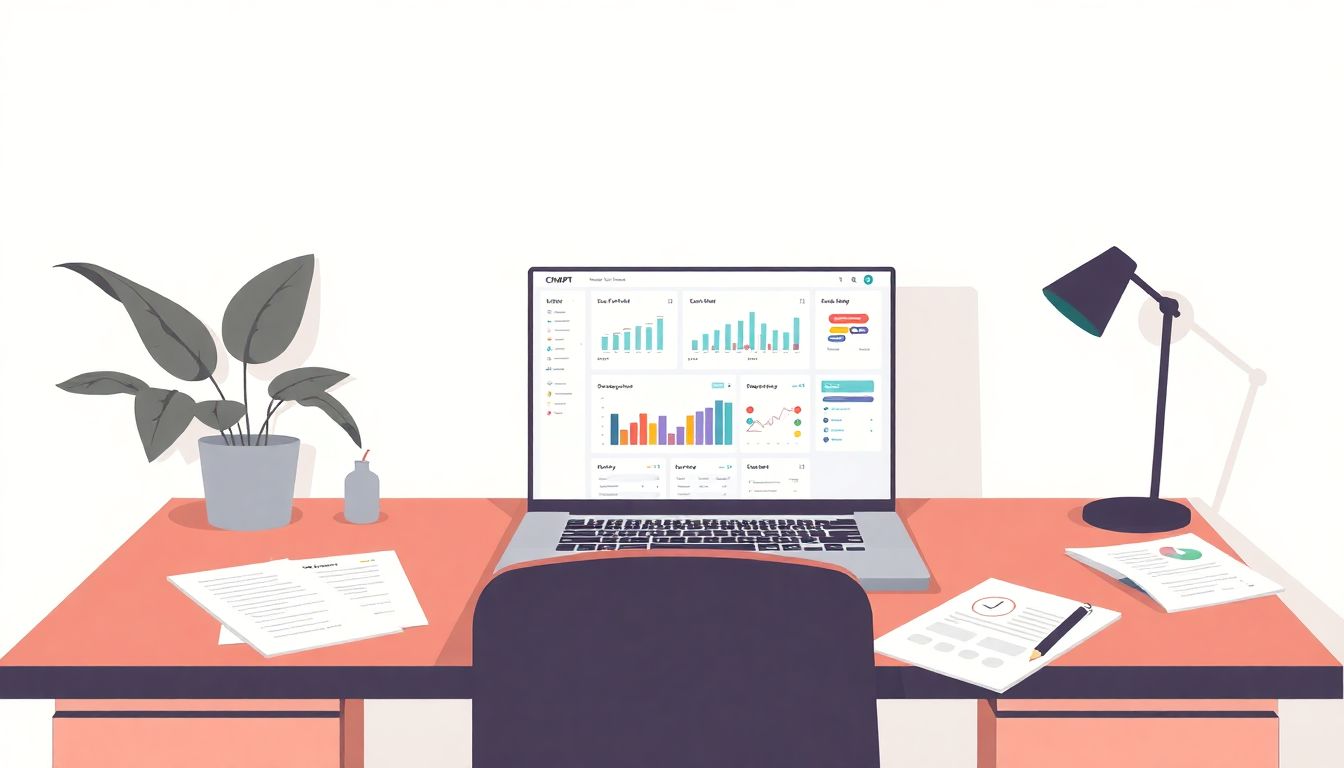Are you feeling a bit overwhelmed by the idea of analyzing your competitors? You’re definitely not alone! With so much information out there, it can be tough to figure out where to start and how to make sense of it all.
But what if I told you that using ChatGPT could simplify this process and give you valuable insights? Stick around, and I’ll show you how to leverage this amazing tool to streamline your competitor analysis and make smarter business decisions.
From understanding its key features to exploring effective prompts, we’ll dive into practical strategies and even some case studies along the way. Let’s get started on transforming your competitor research!
Key Takeaways
- ChatGPT simplifies competitor analysis by quickly gathering insights and processing large data sets.
- Identify your main competitors to form a strong foundation for effective analysis.
- Use targeted prompts to explore competitors’ strengths, weaknesses, and market strategies.
- Compile findings into a summary report to integrate ChatGPT insights with your own observations.
- Always validate AI-generated insights with traditional research methods for accuracy.
- Combine quantitative data from AI with qualitative insights from human sources for a comprehensive analysis.

How to Use ChatGPT for Competitor Analysis in Business
Using ChatGPT for competitor analysis is about leveraging AI to gather insights quickly and efficiently.
With its ability to process vast amounts of information, ChatGPT can help form a clearer picture of the competitive landscape in your industry.
Start by defining your competitors; knowing who you are up against is the first step toward effective analysis.
Once you have your competitors identified, you can use specific prompts in ChatGPT to investigate various aspects like market position, strengths and weaknesses, and current strategies.
This method not only saves time but can also reveal insights that may have otherwise been overlooked.
Understanding Competitor Analysis and Its Importance
Competitor analysis is crucial for any business aiming to stay ahead in a competitive market.
It involves investigating and understanding your competitors’ strategies, strengths, and weaknesses.
By evaluating their market positioning, you can better develop your strategies for growth and innovation.
Understanding your competition helps in identifying market trends, customer preferences, and insights into areas where you can outperform them.
Ultimately, a well-executed competitor analysis can lead to improved decision-making and a stronger market presence.
Key Features of ChatGPT for Business Competitor Insights
ChatGPT comes equipped with several features beneficial for gathering competitor insights.
One of its standout features is the ability to generate contextually relevant summaries of competitor activities.
With natural language processing capabilities, ChatGPT can understand nuances and deliver insights based on structured data.
Another feature is the ability to create customized reports, which can present compiled data on competitors in user-friendly formats.
User queries can also be tailored for exploring specific competitor attributes, allowing for focused investigation.
Steps to Conduct Competitor Analysis Using ChatGPT
Follow these steps to conduct a detailed competitor analysis using ChatGPT:
- Identify Competitors: Start by creating a list of your main competitors.
- Formulate Prompts: Use clear prompts like “List the top three competitors in [your industry] and their strengths.”
- Gather Data: Ask ChatGPT specific questions about market trends or recent news regarding a competitor.
- Analyze Responses: Evaluate the accuracy and relevance of the responses provided.
- Compile Findings: Create a summary report that integrates insights from ChatGPT with your own observations.
By following these steps, you can streamline your competitor analysis process and gather valuable insights tailored to your business needs.

Examples of Effective ChatGPT Prompts for Competitor Analysis
Crafting effective prompts is essential for extracting useful insights from ChatGPT.
Here are some prompt examples that you can copy and paste directly into ChatGPT.
- “Identify and compare the top three competitors in [your industry] along with their strengths, weaknesses, and market strategies.”
- “What are the recent trends impacting [specific competitor] in the [specific market or sector]?”
- “Generate a SWOT analysis for [competitor name] focusing on their product offerings in [specific product category].”
- “List the most innovative marketing strategies utilized by [competitor name] and explain their effectiveness.”
- “What customer feedback has been given for products by [competitor name]? Summarize the reviews.”
- “Analyze the social media presence of [competitor name] and identify engagement patterns with their audience.”
- “Provide an overview of [competitor name]’s pricing strategies compared to the industry standards.”
- “Identify key partnerships or collaborations that [competitor name] has formed recently and their impact on market positioning.”
These prompts allow you to dive deeper into specific areas of competitor analysis, making your research more thorough and valuable.
Interpreting ChatGPT Responses for Better Business Decisions
Interpreting the responses from ChatGPT is crucial to make informed business decisions.
Start by evaluating the relevance of the information to your specific context.
Check for consistency with known data and use follow-up questions for clarification when needed.
If the AI provides insight into competitor strategies, think about how those strategies align with your business goals.
For example, if ChatGPT highlights a competitor’s strong social media engagement, consider whether you can adopt similar practices.
Importantly, contextualize the AI’s insights within your market experience, as not everything will be directly applicable.
Always cross-validate important insights with other data sources to ensure accuracy.
This approach helps turn AI-generated insights into actionable business strategies.
Limitations of Using ChatGPT for Competitor Analysis
While ChatGPT is a powerful tool, it’s not without its limitations.
One major challenge is the accuracy of the information it provides; AI can misinterpret context or provide outdated data.
It’s also important to be aware of potential biases in training data, which could skew results.
ChatGPT lacks the ability to perform real-time data analysis, meaning that you might overlook sudden market shifts or competitor moves.
Furthermore, it may struggle to synthesize nuanced qualitative data that requires human insight.
To counter these limitations, use ChatGPT as a starting point and integrate findings with traditional research methods.
This hybrid approach helps ensure you get a well-rounded view of the competitive landscape while avoiding pitfalls associated with AI-generated data.
Best Practices for Combining ChatGPT with Traditional Competitor Analysis Methods
Combining ChatGPT with traditional methods can enhance your competitor analysis significantly.
Start by using ChatGPT to gather preliminary insights and generate ideas.
Next, validate this information through traditional methods like surveys, interviews, or website analytics.
Consider using ChatGPT to suggest questions for customer interviews or focus groups, shaping your traditional research direction.
Another approach is to compile the data from ChatGPT and compare it against reports from industry analysts or market research firms.
Don’t forget to include qualitative data such as customer experiences or employee feedback, which are often not captured by AI alone.
The combination of quantitative data from AI and qualitative insights from human sources creates a more comprehensive picture.
This integrated method leads to better decision-making and more robust business strategies based on a wide range of insights.

Case Studies: Successful Use of ChatGPT in Competitor Research
Looking at case studies can help clarify how businesses have effectively used ChatGPT for competitor research.
For instance, a tech startup used ChatGPT to analyze their competitors’ product features.
The startup generated a detailed comparison of user reviews, pricing strategies, and marketing approaches.
This analysis led them to identify a gap in seamless integration features that they then capitalized on.
Another case involved a retail company using ChatGPT to assess their competitors’ social media strategies.
By prompting ChatGPT to summarize engagement tactics and audience responses, they adapted their approach.
The result was a 25% increase in user engagement on their own social media platforms.
Utilizing ChatGPT allowed these companies not just to gather data, but to pivot their strategies effectively based on insights.
So, if you’re thinking of incorporating ChatGPT in your competitor analysis, looking into real-world examples might spark your creativity.
Future Trends: Evolving Use of AI in Business Analysis
The future of AI, particularly in business analysis, is exciting and dynamic.
As technology evolves, so will the capabilities of tools like ChatGPT.
For example, we’re likely to see more personalized insights generated by AI as it becomes adept at understanding individual business contexts.
Additionally, predictive analytics will play a significant role; businesses will be able to foresee competitor behaviors based on historical data provided by AI.
ChatGPT might also incorporate real-time data analysis, allowing for immediate updates on competitor moves.
With growing integration of AI in decision-making processes, companies will have improved agility in strategy adjustments.
So keep your eyes peeled as these trends develop; leveraging them could set your business apart from the competition.
FAQs
ChatGPT aids in competitor analysis by providing insights on competitor strategies, market positioning, and customer perceptions. Its ability to analyze large texts and generate summaries makes it a useful tool for gathering relevant information quickly.
To effectively use ChatGPT for competitor insights, formulate clear and specific prompts. Ask targeted questions about competitors’ marketing strategies, product features, and customer feedback to extract valuable and actionable insights for your business.
While ChatGPT is adept at processing language, it has limitations in real-time data retrieval and may not provide the latest insights. Additionally, it lacks context and may misinterpret nuanced competitive factors without detailed prompts.
Combining ChatGPT with traditional methods involves using it for preliminary research and trend analysis, then verifying results with in-depth competitor reports or market surveys. This hybrid approach provides a comprehensive understanding of the competitive landscape.
